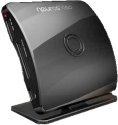TI frees its DSP toolchain for open source apps
Nov 16, 2007 — by LinuxDevices Staff — from the LinuxDevices Archive — 41 views[Updated 6 P.M.] — Texas Instruments (TI) is offering open source developers free use of its closed-source toolchain for DSPs (digital signal processors) found in several popular TI OMAP and DM-series RISC/DSP chips. The first-of-its-kind release may lower cost barriers for prospective developers of open source video codecs, motion sensors, and other “number-crunching” applications.
digg this story |
The toolchain is being distributed by Neuros (formerly Neuros Audio), the small, scrappy Linux device company that negotiated the release. Neuros Founder Joe Born recalls, “We spent many months with TI working with a few different initiatives, and convinced them to let us redistribute [the toolchain]. At first, they sent it to us with a standard evaluation license. We negotiated for a few months, and eventually arrived at a license similar to dual-license, where it's free for use in open source projects, and you can basically use it for whatever you want.”
 Neuros OSD (Click for details) |
Neuros hopes the compiler release — combined with an interesting ARM-DSP bridge developed by a Google “Summer of Code” intern — will allow aspiring DSP coders to use its $200 “Open Source Device” as a development target, instead of paying $3,000 for TI's DSP development boards and Code Composer Studio tools. The OSD is based on a TI DM320, and features a C54x DSP clocked at 120MHz. The C54x is also found in DM270 parts. As for other Linux devices? Brn said, “There are Cowon and other devices that use the c54x, but I'm trying to figure out exactly which.”
The toolchain includes a compiler, optimizer, assembler, and linker, but not a debugger, which would require an expensive JTAG probe anyway, the company maintains. Born commented, “It's in a usable form today, and some folks have been playing around with it [with success]. The traditional TI dev environment has a JTAG emulator and graphical tools, but on the Linux side, many people don't need all of that.”
Neuros hopes that one of the first things people will use the free compiler for will be to create more open source codecs for the OSD. In a blog post announcing the release, Neuros community developer Adam Torgerson wrote, in part, “With [this release], intrepid hackers will be able to write an audio driver, and port open source codecs, such as libmad, Tremor, and perhaps some video codecs to the DSP. With enough progress, one day the OSD will no longer need [closed source software at all].”
And what else, besides codec development, could the toolchain be used for? In a conversation with LinuxDevices, Born explained, “If you follow TI's customers, they're always doing interesting stuff. Facial recognition, secret military stuff, and advanced motion sensing. So, for example, if a simple algorithm in a light switch can distinguish between wind blowing a paper off the desk and a person walking into the room, you can get an energy savings.”
Born believes that wider access to DSP tools could result in new, as-yet unimagined applications. He recounts an anecdote in which Robert Oppenheimer was asked what German scientists would need in order to re-create the atom bomb. “'They'd need to know that we did it,' Oppenheimer replied. Well, if one day, somebody gets high-definition processing going on one DSP, everyone else is going to say, 'We have to do that, too!'”
And that's exactly the kind of breakthrough that low-cost DSP programming tools could bring, suggests Born. He explains, “I'm not a codec developer myself, but time and time again, these advanced codecs are almost always the work of a single developer. [Codec programming] is not modular, or object oriented, or a big behemoth programming project. It's just a tightly optimized algorithm that you have to keep in your head.”
More details about the release — including the free download and its license — can be found on Neuros's website, here.
This article was originally published on LinuxDevices.com and has been donated to the open source community by QuinStreet Inc. Please visit LinuxToday.com for up-to-date news and articles about Linux and open source.